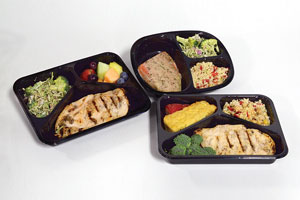Using the proper packaging materials is crucial in ensuring the freshness, improved shelf life, and safe transport of seafood products. At Point Five Packaging, we offer a wide range of seafood packaging solutions that deliver substantial benefits. Our seafood packaging systems and materials facilitate production flexibility and adhere to all the necessary quality standards to ensure optimal safety and freshness.
Importance of Seafood Packaging
Seafood packaging plays an important role in retaining the quality of seafood products by enhancing shelf life, facilitating rapid freezing, inhibiting microbial growth, reducing the risk of freezer burn, and more. Utilizing the proper fish packaging can protect products from experiencing contamination, dehydration, and oxidation, which is key in preventing spoilage. Additionally, adequate packaging can stop odors from escaping and lower the risk of dripping, allowing seafood products to be placed in shopping carts or baskets without contaminating other purchases.
Types of Advanced Seafood Packaging Solutions
At Point Five Packaging, we offer a wide range of advanced seafood packaging solutions, including:
- Vacuum Skin Packaging (VSP). Vacuum skin packaging, or VSP, is commonly used to package fish filets and other seafood products. This method not only maximizes shelf life but also enhances presentation. VSP works by combining a transparent, flexible plastic film with a paperboard backing.
- Modified Atmosphere Packaging (MAP). This seafood packaging option involves flushing a tray with an inert, safe natural gas such as carbon dioxide or nitrogen. Doing so reduces the oxygen residual within the package from 20% to below 0.5%. By reducing the amount of oxygen, MAP packaging extends the shelf life of seafood products while preserving quality and freshness.
- Tray Sealing. In tray sealing, the product is sealed with a tray using printed or transparent plastic film. This method is not ideal for extending shelf life; therefore, it is most suitable for shelf-stable or frozen seafood products.
- Tray Stretch Sealing. With this method, the tray is sealed with a specialized stretch film, creating a hermetic seal capable of keeping liquids such as blood or brine in the tray. This is extremely beneficial as it prevents leakage during storage or transport. Tray stretch sealing helps to retain product weight and integrity, and it is a great option for seafood, meat, and poultry.
Choosing the Right Seafood Packaging Solution for Your Business
When choosing the right seafood packaging for your products, there are several key factors to consider:
- Material. Seafood packaging is available in various materials; therefore, it’s important to consider the type of seafood being packaged, its size and weight, and whether it requires specialized handling or storage. For example, more delicate seafood products, such as scallops, may require protective and more durable packaging materials like vacuum-sealed bags. Other common seafood packaging materials include Amorphous Polyethylene Terephthalate (A-PET) containers and trays, Crystallized Polyethylene Terephthalate (C-PET) containers and trays, and Polypropylene (PP) containers. In the USA, FDA guidelines dictate the use of high O2 transmission materials to limit the occurrences of listeria and botulism in fresh seafood.
- Sustainability. With the rising demand for environmentally friendly packaging, consider using more sustainable options such as recyclable, compostable, or biodegradable packaging materials.
- Size and shape. The size and shape of your seafood packaging can impact transport and storage efficiency. Consider the amount of shelf space you have and the size of your transport containers. Oftentimes, using standard-sized packaging can help to optimize shipping and storage.
- Branding. Packaging can be used to elevate your brand and separate you from competitors. Consider using aesthetically pleasing packaging that includes strong branding and information such as your product’s nutritional content, origin, and freshness.
- Regulatory requirements. Make sure your seafood packaging and labeling adhere to the necessary regulatory requirements, such as USDA and FDA regulations.
Seafood Packaging Solutions From Point Five Packaging
With various packaging materials and technologies to choose from, it can be challenging to determine the right solution for your seafood packaging needs. At Point Five Packaging, we are an industry leader in MAP systems and other packaging solutions designed to enhance product appeal, functionality, and shelf life. For more information about our seafood packaging options and capabilities, or for help determining the right packaging solution for your application, contact us or request a quote today.

